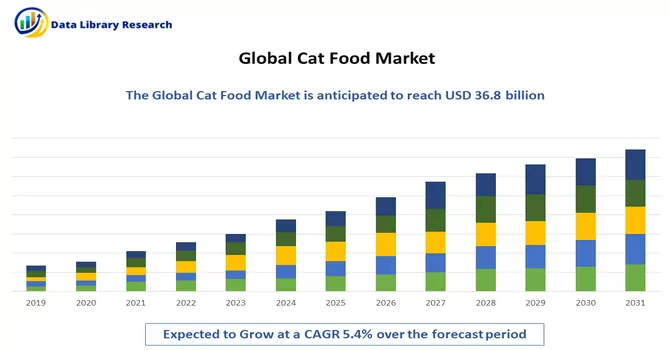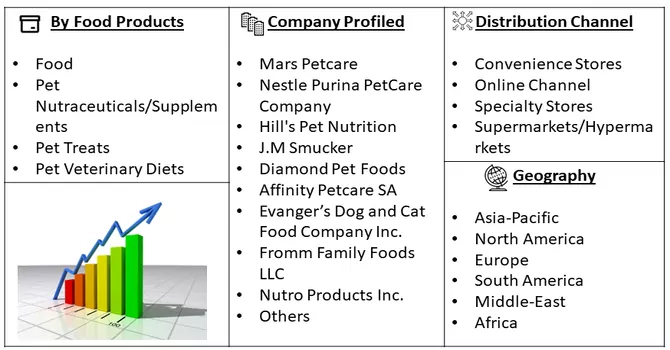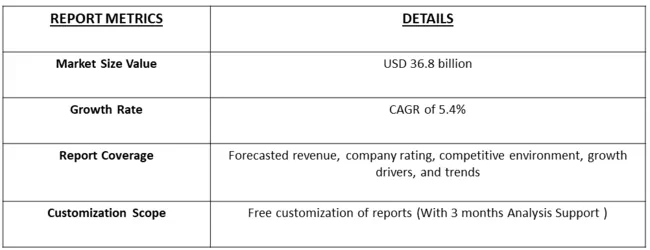The global cat food market size was estimated at USD 36.8 billion in 2023 and is anticipated to grow at a compounded annual growth rate (CAGR) of 5.4% from 2024 to 2031.

Get Complete Analysis Of The Report - Download Free Sample PDF
The Cat Food market, a significant segment within the broader pet food industry, caters specifically to the nutritional needs and preferences of domestic cats. This market encompasses a diverse range of products, including dry kibble, wet or canned food, treats, and speciality formulations designed for different life stages and health conditions. With a growing awareness of the importance of pet health and the human-animal bond, cat owners increasingly seek high-quality, nutritionally balanced cat food options.
The market reflects ongoing trends such as the demand for natural and organic ingredients, grain-free formulations, and novel protein sources. As consumers prioritize the well-being of their feline companions, the Cat Food market continues to evolve, offering a variety of options that meet the nutritional requirements and taste preferences of cats while aligning with the values of pet owners. A primary growth-driving factor for the Cat Food market is the rising emphasis on pet health and wellness coupled with the growing pet humanization trend. Pet owners increasingly view their cats as integral members of the family, leading to a heightened awareness of the importance of providing optimal nutrition. As a result, there is a growing demand for cat food products that not only meet essential dietary needs but also address specific health concerns and cater to different life stages. The market sees continual innovation, including the development of formulations with natural and organic ingredients, novel proteins, and customized options for dietary preferences such as grain-free or hypoallergenic diets. This trend reflects a consumer-driven shift towards prioritizing the overall well-being and longevity of cats, driving the growth and diversification of the Cat Food market.
Market segmentation: The Cat Food Market is segmented by Pet Food Products (Food, Pet Nutraceuticals/Supplements, Pet Treats, Pet Veterinary Diets), by Distribution Channel (Convenience Stores, Online Channel, Specialty Stores, Supermarkets/Hypermarkets) and by Region (Africa, Asia-Pacific, Europe, North America, South America). The market volume and value are presented in metric ton and USD respectively. The key data points include the market size of pet food by-products, distribution channels, and pets.

For Detailed Market Segmentation - Download Free Sample PDF
The Cat Food market is witnessing several notable trends that reflect evolving consumer preferences and industry innovations. One prominent trend is the growing demand for premium and specialized cat food formulations. Pet owners are increasingly seeking high-quality, nutritionally dense options that address specific health concerns or cater to life-stage requirements. This trend includes the rise of grain-free, natural, and organic cat food varieties, reflecting a broader consumer shift towards healthier and more natural pet diets. Another significant trend is the increasing popularity of alternative protein sources, such as novel meats or plant-based ingredients, as pet owners explore diverse dietary options for their feline companions. Additionally, the emphasis on sustainability and eco-friendly packaging is gaining traction, aligning with consumers' broader environmental concerns. As the Cat Food market continues to evolve, these trends highlight the dynamic nature of consumer preferences and the industry's commitment to meeting the diverse needs of cat owners.
Market Drivers:
Humanization of pets
The humanization of pets is a prevailing societal trend characterized by the increasing perception of pets, particularly dogs and cats, as valued family members rather than mere animals. This phenomenon involves treating pets with the same level of care, attention, and even indulgence as one would extend to human family members. Pet owners are increasingly inclined to provide their animals with premium food, personalized healthcare, and a variety of accessories and services, reflecting a desire to enhance their pets' overall quality of life. This trend has influenced various industries, including pet food, leading to the development of premium and specialized products that align with the human preferences and lifestyle choices of pet owners. As a result, the humanization of pets continues to shape the pet care market and foster a deeper emotional connection between owners and their beloved animal companions.
Pet health and wellness
The focus on pet health and wellness represents a significant paradigm shift in how pet owners approach the care of their animal companions. With an increasing awareness of the role nutrition plays in the overall well-being of pets, there has been a growing emphasis on providing optimal healthcare, balanced diets, and preventive measures. Pet owners are proactively seeking out products and services that promote the physical and mental health of their pets, including specialized diets, supplements, and veterinary care. This trend has spurred innovations in the pet industry, leading to the development of functional and therapeutic pet foods, fitness trackers, and wellness-oriented services. As a result, the focus on pet health and wellness is not only transforming the pet care landscape but also deepening the bond between owners and their pets by ensuring a healthier and happier life for their furry companions.
Market Restraints:
Market restraints for the Cat Food market include challenges related to consumer education and awareness. Despite the growing interest in premium and specialized cat food options, there remains a segment of cat owners who may not fully comprehend the nutritional needs or specific dietary requirements of their feline companions. Educating consumers about the importance of proper cat nutrition, deciphering ingredient labels, and understanding individual cat preferences can be a hurdle. Additionally, price sensitivity among certain consumer demographics may limit the adoption of premium cat food products. Economic factors influencing disposable income and purchasing decisions may lead some cat owners to opt for more cost-effective alternatives, affecting the market dynamics. Moreover, the proliferation of pet food choices and brands can create a saturated market, making it challenging for companies to differentiate their offerings and establish brand loyalty. Addressing these challenges through targeted marketing, educational initiatives, and price strategies will be crucial for the sustained growth of the Cat Food market.
The COVID-19 pandemic has had a multifaceted impact on the Cat Food market. While the pet industry, in general, experienced increased demand as more people sought companionship during lockdowns, the specific dynamics of the cat food market underwent notable shifts. With lockdowns and restrictions altering consumer behaviour, there was a surge in pet adoption, contributing to an uptick in the demand for cat food. However, supply chain disruptions, logistical challenges, and economic uncertainties also affected the market. Some cat owners, facing financial constraints, may have shifted towards more economical cat food options, impacting sales of premium and specialized products. Additionally, changes in consumer lifestyles, such as remote work, influenced pet owners' purchasing patterns. As the world adapts to the ongoing effects of the pandemic, the Cat Food market continues to navigate these complexities, with a renewed focus on e-commerce channels and heightened awareness of pet health and nutrition.
Segmental Analysis:
Pet Veterinary Diet Market Segment is Expected to Significant Growth Over the Forecast Period
The Pet Veterinary Diets and Cat Food Market represent critical segments within the pet care industry, responding to the evolving dietary needs and health considerations of feline companions. As pet owners increasingly prioritize the well-being of their cats, the market has seen a surge in demand for specialized veterinary diets designed to address specific health conditions. This niche market not only offers tailored nutrition solutions but also emphasizes preventive care, contributing to the overall health and longevity of cats. The Cat Food Market, within this context, has witnessed a paradigm shift with an emphasis on high-quality ingredients, nutritional balance, and diverse flavour profiles to cater to discerning feline palates. As the bond between pets and their owners deepens, the Pet Veterinary Diets and Cat Food Market are poised for continued growth, driven by a confluence of factors such as pet humanization, increased awareness of pet health, and a desire for premium and specialized nutritional offerings in the pet food sector.
Supermarkets/Hypermarkets Segment is Expected to Significant Growth Over the Forecast Period
Supermarkets and hypermarkets play a central role in the distribution and accessibility of cat foods, acting as pivotal channels in the Cat Food Market. These retail giants offer a wide array of cat food brands, catering to the diverse preferences and nutritional needs of pet owners. The convenience, variety, and competitive pricing provided by supermarkets and hypermarkets contribute significantly to the consistent growth of the Cat Food Market. As consumers increasingly prioritize convenience and one-stop shopping, these retail formats serve as crucial platforms for both established and emerging cat food brands to reach a broad customer base. The strategic placement of cat food products within the pet care aisle of supermarkets and hypermarkets enhances visibility, fostering impulse purchases and brand loyalty. With the pet industry witnessing a surge in demand for premium and specialized cat food variants, supermarkets and hypermarkets play a vital role in shaping the dynamics of the Cat Food Market, offering a seamless shopping experience for pet owners seeking high-quality and tailored nutrition for their feline companions.
North America Region is Expected to Significant Growth Over the Forecast Period
The Cat Food Market in North America reflects a robust and evolving landscape driven by the region's profound pet culture and a heightened focus on pet nutrition. With a discerning consumer base increasingly considering cats as integral family members, the market witnesses a surge in demand for premium, nutritious, and specialized cat food options. North America's cat owners exhibit a preference for high-quality ingredients, diverse flavour profiles, and formulations addressing specific health needs, leading to a proliferation of innovative products within the market. The region's Cat Food Market is notably influenced by trends such as natural and organic ingredients, grain-free formulations, and an emphasis on veterinary-endorsed diets. As pet humanization continues to shape consumer behaviour, North America remains at the forefront of advancing the Cat Food Market, with supermarkets, speciality pet stores, and online platforms serving as key distribution channels. The region's commitment to pet wellness, coupled with a dynamic retail landscape, positions North America as a significant player in shaping the trajectory of the Cat Food Market, where the intersection of pet care trends and consumer preferences continues to drive innovation and market growth.

Get Complete Analysis Of The Report - Download Free Sample PDF
The analyzed market exhibits a high degree of fragmentation, primarily attributable to the presence of numerous players operating on both a global and regional scale. The competitive landscape is characterized by a diverse array of companies, each contributing to the overall market dynamics. This fragmentation arises from the existence of specialized solution providers, established industry players, and emerging entrants, all vying for market share. The diversity in market participants is underscored by the adoption of various strategies aimed at expanding the company presence. On a global scale, companies within the studied market are strategically positioning themselves through aggressive expansion initiatives. This often involves entering new geographical regions, targeting untapped markets, and establishing a robust global footprint. The pursuit of global expansion is driven by the recognition of diverse market opportunities and the desire to capitalize on emerging trends and demands across different regions. Simultaneously, at the regional level, companies are tailoring their approaches to align with local market dynamics. Regional players are leveraging their understanding of specific market nuances, regulatory environments, and consumer preferences to gain a competitive edge. This regional focus allows companies to cater to the unique needs of local clientele, fostering stronger market penetration. To navigate the complexities of the fragmented market, companies are implementing a range of strategies. These strategies include investments in research and development to stay at the forefront of technological advancements, mergers and acquisitions to consolidate market share, strategic partnerships for synergies, and innovation to differentiate products and services. The adoption of such multifaceted strategies reflects the competitive nature of the market, with participants continually seeking avenues for growth and sustainability. In essence, the high fragmentation in the studied market not only signifies the diversity of players but also underscores the dynamism and competitiveness that drive ongoing strategic manoeuvres. As companies explore various avenues for expansion, the market continues to evolve, presenting both challenges and opportunities for industry stakeholders.
Recent Development:
1) In July 2023, Hill's Pet Nutrition unveiled an innovative line of pet products featuring MSC (Marine Stewardship Council) certified pollock and insect protein, specifically designed for pets with sensitive stomachs and skin concerns. This introduction highlights a commitment to sustainable sourcing, incorporating essential nutrients such as vitamins, omega-3 fatty acids, and antioxidants to promote overall pet health.
2) In June 2023, Mars Incorporated expanded its premium cat brand SHEBA into the Canadian market, introducing wet formulas under the SHEBA BISTRO line. This strategic move enhances the brand's global presence, offering Canadian cat owners access to high-quality, gourmet options for their feline companions. Both initiatives underscore the ongoing industry focus on sustainability, nutritional advancements, and international market expansion to meet the evolving needs of pet owners worldwide.
Q1. What was the Cat Food Market size in 2023?
As per Data Library Research the global cat food market size was estimated at USD 36.8 billion in 2023.
Q2. At what CAGR is the Cat Food market projected to grow within the forecast period?
Cat Food Market is anticipated to grow at a compounded annual growth rate (CAGR) of 5.4% over the forecast period.
Q3. What are the Growth Drivers of the Cat Food Market?
Humanization of pets and Pet health and wellness are the Growth Drivers of the Cat Food Market.
Q4. What are the factors on which the Cat Food Market research is based on?
By Pet Food Product, By Distribution Channel and Geography are the factors on which the Cat Food Market research is based.
Data Library Research are conducted by industry experts who offer insight on industry structure, market segmentations technology assessment and competitive landscape (CL), and penetration, as well as on emerging trends. Their analysis is based on primary interviews (~ 80%) and secondary research (~ 20%) as well as years of professional expertise in their respective industries. Adding to this, by analysing historical trends and current market positions, our analysts predict where the market will be headed for the next five years. Furthermore, the varying trends of segment & categories geographically presented are also studied and the estimated based on the primary & secondary research.
In this particular report from the supply side Data Library Research has conducted primary surveys (interviews) with the key level executives (VP, CEO’s, Marketing Director, Business Development Manager and SOFT) of the companies that active & prominent as well as the midsized organization
FIGURE 1: DLR RESEARH PROCESS

Extensive primary research was conducted to gain a deeper insight of the market and industry performance. The analysis is based on both primary and secondary research as well as years of professional expertise in the respective industries.
In addition to analysing current and historical trends, our analysts predict where the market is headed over the next five years.
It varies by segment for these categories geographically presented in the list of market tables. Speaking about this particular report we have conducted primary surveys (interviews) with the key level executives (VP, CEO’s, Marketing Director, Business Development Manager and many more) of the major players active in the market.
Secondary ResearchSecondary research was mainly used to collect and identify information useful for the extensive, technical, market-oriented, and Friend’s study of the Global Extra Neutral Alcohol. It was also used to obtain key information about major players, market classification and segmentation according to the industry trends, geographical markets, and developments related to the market and technology perspectives. For this study, analysts have gathered information from various credible sources, such as annual reports, sec filings, journals, white papers, SOFT presentations, and company web sites.
Market Size EstimationBoth, top-down and bottom-up approaches were used to estimate and validate the size of the Global market and to estimate the size of various other dependent submarkets in the overall Extra Neutral Alcohol. The key players in the market were identified through secondary research and their market contributions in the respective geographies were determined through primary and secondary research.
Forecast Model
